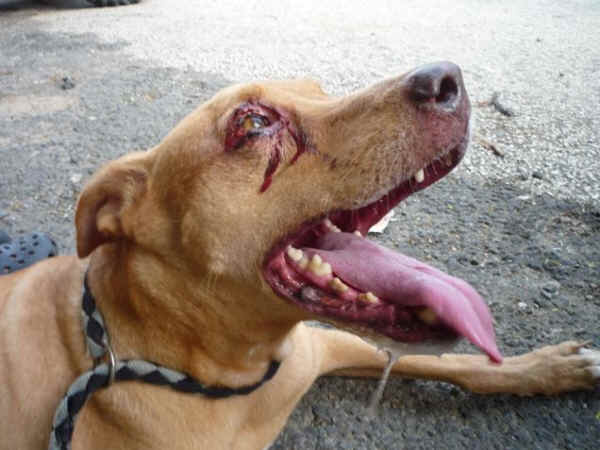Dog and Cat Bleeding: What To Do To Stop It Fast
If your dog or cat is bleeding, you want to know why this is happening, and what you can do to stop it fast. This article will show you the most important causes of bleeding in dogs and cats, and then show you how to tell whether or not it is serious. You will then learn what remedies and techniques you can use at home to stop your pet from bleeding.
It often looks worse than it appears. A small pad cut can look horrible when only a small amount of blood is lost. Deep wounds involving arteries or veins are most serious. A cut artery will often “spurt” blood. Most superficial bleeding can be treated at home, while all deep wounds need veterinary care.
All serious bleeding requires veterinary care, while small wounds can be treated at home. These serious wounds require your veterinarian to perform surgery, ligating the vessel that it the source of the bleeding.
Applying pressure is key. The first thing is to control the bleeding. Apply a gauze pad or a clean piece of cloth on the bleeding area. If blood soaks through, then re-apply another gauze pad over top. It is important not to remove the clot that will form to ultimately stop the bleeding. In extensive bleeding, some form of a pressure bandage will need to be applied. Wrap the gauze or cloth with a roll of bandage. Your Pet First Aid Kit will have roll gauze inside. A tensor bandage will also work.
Pressure points can markedly reduce the volume of blood, and may save your pet’s life. It helps to know where the arteries are located near the surface of the skin. In these cases you can apply pressure with your finger to reduce blood flow and allow a clot to form. Front Leg – The radial artery can be located in the armpit; use 3 fingers and apply firm pressure. Rear Leg- The femoral artery can be located in the groin, where the rear leg starts. Apply firm pressure. Tail- The Main coccygeal (tail) artery and vein run along the base of the tail. Apply firm pressure at the tail base to stop bleeding.
Pets who lose a lot of blood rapidly can go into Shock, in which the blood flow to their major organs shuts down; if not treated quickly, your pet can die. The major thing is assessing your pet’s blood pressure via gum color and CRT (time for the blood to return the gums after you apply pressure). Pale gums and a long CRT are signs of serious shock; this means that your pet needs immediate veterinary care. Wrap him in a blanket, give him a teaspoon of honey, and transport immediately to your veterinarian.
Elevate a bleeding limb. Raising the injured leg will slow down bleeding. This works best for injuries of the paw. Don’t do this if you suspect that the leg is broken.
Earflap wounds are a special case. They love to bleed, and as your pet shakes her head, blood flies everywhere. First apply pressure with a gauze pad. Then try to keep the entire ear tight to the head. This is best done with a panty hose; slip it over your pet’s head covering the ears, leaving the rest of the face open.
Nose bleeding is a special situation, and here are a few specific points you need to be aware of. Usually a blow to the nose causes this. First try to calm your pet as this will help to reduce blood pressure and slow bleeding. Tilt the head down so that the blood runs out of the nose not down the back of the throat. Apply cold damp towels on the forehead and around the back of the neck. Seek veterinary advice if the bleeding does not stop in 5 – 10 minutes. Continued bleeding may indicate your pet has a clotting problem, a dental abscess or tumor. When you place gauze up your pet’s nose, they are inclined to sneeze it out, along with the blood clot, causing the bleeding to start all over again. Do not put anything up your pet’s nose.
There are many causes of bleeding in dogs and cats; you must first be able to assess how serious the bleeding is and whether or not your pet requires veterinary care. You can apply pressure, and use pressure points to control serious bleeding. You should now be able to recognize signs of shock, and then help this by elevating a bleeding limb. If there is bleeding from an ear, or nose, use some of the suggested home remedies.
Heal Your Pet At Home!
Best Wishes,
Dr Andrew Jones, DVM
P.S. If you liked this article, then I encourage you to sign up for my newsletter where you’ll get my Free Book and Videos on How To Heal Your Pets At Home with my TOP Natural Remedies.
The big key to having a healthy dog or cat is also knowing WHAT to do to prevent common dog and cat diseases in the first place.
Such as knowing what to feed, what vaccines to give and avoid, and what natural treatments you can use to treat chronic illnesses such as allergies.
I’ll show you precisely what you can do immediately to both prevent and treat diseases in your dog or cat; you’ll be using my holistic tips and remedies with simple easy to follow instructions.
Sound interesting?
Enter your name and email address below and click “Sign Me Up” to get free updates:

For nosebleed I found pressing the acupoint LI 4 most beneficial. It stops a nosebleed within a few minutes.
HOW DO YOU STOP BLEEDING>from cutting your DOG’S NAILS??? Trimming nails..Tried Putting “PAW” into cup of “FLOUR”> BLEED EVEN MORE!!! PLEASE HELP!! IF I HAVE NO OINTMENT HERE @ HOME!! OKay!! ??